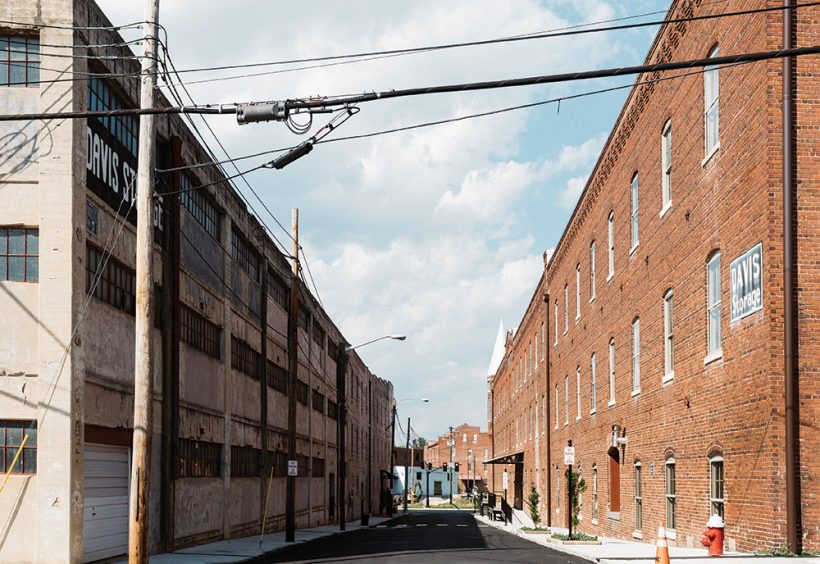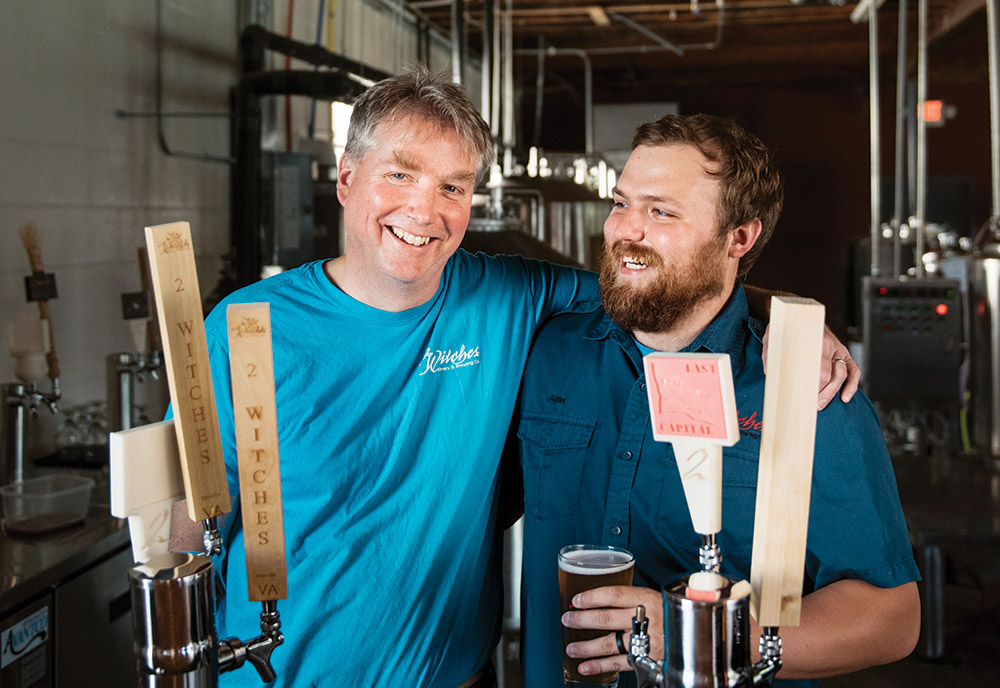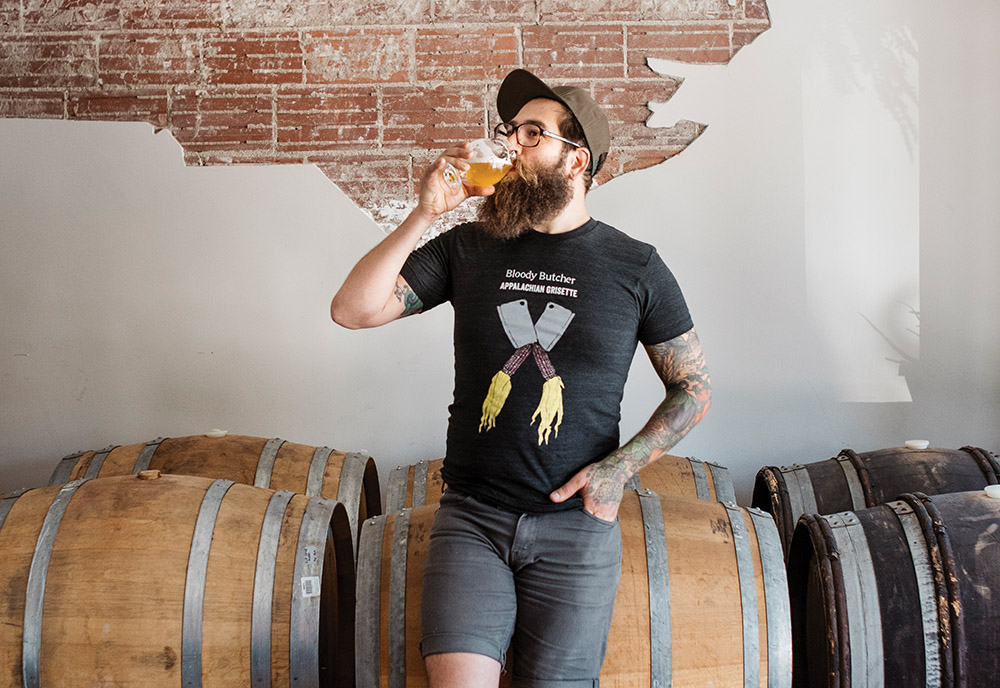Building Beertown: The Economic Allure of Brewing for Three Small Communities
Feature by Bryan Roth | Aug 2017 | Issue #127
 Danville, Va.’s River District, where historic warehouses are being redeveloped for residential and commercial use, including Ballad Brewing’s 16,000-square-foot space. | Photos by Jack Sorokin
Danville, Va.’s River District, where historic warehouses are being redeveloped for residential and commercial use, including Ballad Brewing’s 16,000-square-foot space. | Photos by Jack Sorokin




 Danville, Va.’s River District, where historic warehouses are being redeveloped for residential and commercial use, including Ballad Brewing’s 16,000-square-foot space. | Photos by Jack Sorokin
Danville, Va.’s River District, where historic warehouses are being redeveloped for residential and commercial use, including Ballad Brewing’s 16,000-square-foot space. | Photos by Jack Sorokin
Danville, Va., was a textile town, booming with thousands of manufacturing jobs.
Then, like so many others, it wasn’t.
Located along the Dan River in south Virginia, a short distance from the state’s border with North Carolina, the small city flourished in the early 20th century thanks to businesses like Riverside Cotton Mills. When it merged with another mill and eventually became Dan River Inc. not long after World War II, it was the largest textile mill in the Southeast, employing around 5,000 North Carolina residents, many from the city and nearby communities.
But a more globalized world struck Danville’s bottom line, as the production and sale of fabric moved elsewhere. Modernization also came for the city’s economic reliance on tobacco and the railroad industry. In 2007, Preservation Virginia, a nonprofit dedicated to revitalizing the state’s historic places, listed the entire city on its “Most Endangered Historic Sites,” a designation spurred in part by nearly 1 million square feet of unused warehouse space that lines about five blocks of downtown’s Craghead Street. In the last 25 years, Danville’s population fell by roughly 20 percent.
For a city so defined by its past, it’s now looking to a decidedly trending business to help guide its future: beer.
It started with Vintages by the Dan, a bottle shop that opened in 2012 and in its first five years, increased dollar sales six times over. Then, 2 Witches Winery and Brewing Co. opened in 2014, and in June 2017, Ballad Brewing opened in 16,000 square feet of empty warehouse space. A third brewery, Preservation Ale & Smokehouse, is planned for 2018 just a few storefronts down from Ballad. On a second floor of that same building, Danville Community College is installing classrooms and small brewing “labs” as part of a new, for-credit brewing technology program that will partner with all three breweries for internships, providing a pathway into the industry—and hopefully one that will keep some students local when it’s time to go pro.
“We used to be one of the most prosperous cities in Virginia with tobacco, farming, and textiles, but so many people have left,” says Bruce Scism, president of Danville Community College. “This is a city no longer saying ‘this is what we used to be.’ This is the city saying, ‘this is what we are.’”

Rod Tomlinson of bottle shop Vintages by the Dan, which ignited Danville’s beer industry when it opened in 2012. | Photo by Jack Sorokin.
In a definitive way, Danville is living up to a mantra often repeated by the Brewers Association, noting that breweries are opening everywhere—urban and rural communities—and 78.5 percent of drinking-age adults now live within 10 miles of such a business. The industry is in rapid expansion, and municipalities of all sizes are looking to beer as a way to get tourists to visit and visitors to consider becoming residents. Now, more than ever, beer’s historic place as a social connector is seen as an opportunity to change the fate of Main Streets across the country.
“The city is ripe for and eager for a rebirth,” says Ballad Brewing co-founder Ross Fickenscher, who, along with business partner Garrett Shifflett, invested about $1.7 million into the company that is projected to produce $47,000 of tax revenue in its first year. They also received about $180,000 in state and city grants for the project. “With the removal of large tobacco and textile businesses, the city has continued to reel from those events and has a real issue on its hands with lack of occupancy downtown and lack of jobs. We believe there’s a lot of positive energy to try to reinvent Danville.”
For decades, young people have been sought out as the base for economic growth to stimulate and change cities and towns. Millennials, those born between the early 1980s and the early 2000s, number almost 75.5 million, making them the largest generation in America and a pivotal force that now steers the direction of economy and culture alike. It just so happens that this group also really enjoys beer and the feeling of experiencing something authentic that can come from visiting breweries and beer-focused businesses. This has not been lost on Danville’s leadership, which has sent representatives from its Office of Economic Development to the Craft Brewers Conference the last three years, setting up a large booth on the tradeshow floor in an attempt to attract people to visit or businesses to open in the city of about 43,000.
Change is already taking hold locally.
“This was a Bud Light town 10 years ago,” says Todd Sparks, 46, a lifelong resident of Danville, echoing a statement mentioned repeatedly and independently by locals, business owners, and city officials. On a June afternoon, Sparks was buying Alpine’s Duet IPA and Ommegang’s Rosetta Kriek at Vintages by the Dan to restock his fridge. It wasn’t too long ago he had to make a weekly, two-hour round trip to Greensboro, N.C., to find full-flavored beer, buying Magic Hat and Avery bottles across the border to bring home.
“It’s not a knock against Danville,” Sparks says of now buying packaged beer or getting a pint poured from a tap connected to a bright tank at Ballad Brewing, “but it almost feels like I’m traveling out of town.”

Ethan and Alex Brown of 2 Witches Winery & Brewing Co., the first craft brewery to open in Danville, Va. | Photo by Jack Sorokin.
It’s that kind of shift in focus and expectation that continues to pop up in nearby communities, and in similar places nationwide. Both Virginia and North Carolina have surpassed 200 breweries, and across a swath of the Mid-Atlantic, small towns see the success of beer in larger cities like Roanoke and Asheville and are wondering, ‘Why not us?’
“We need variety,” says Todd Tucker, president of North Carolina’s Surry County Economic Development Partnership, which oversees four municipalities with a combined population of about 73,000. “Like a lot of other rural communities, we’re losing our young people to bigger cities because they have more things to do and places to go. We need things like restaurants, shopping, and breweries to attract and retain our young people, because that’s the stuff they like. This is what’s going to get people to come visit, but also consider moving here.”
In the past two years, Tucker has focused his efforts on trying to get small production breweries to consider Mt. Airy, N.C., a city 80 miles west of Danville with just over 10,000 residents. Population growth has been flat for Mt. Airy and Surry County for years, Tucker notes, and beer can provide the kind of “value added” businesses a town like Mt. Airy needs, because a brewery brings people downtown and has the potential to keep them around to visit other stores and attractions.
Tucker also points out that the area already boasts some of the best schools in the state and offers lots of opportunity for outdoor activities like hiking or mountain biking. Adding one more thing young families might consider as valuable to quality of life could be a boon for the town. At the moment, a consistent point of marketing for Mt. Airy is to bill itself as the hometown of Andy Griffith, and to host an annual “Mayberry Days” festival to celebrate the actor’s beloved 1960s TV show.
“With the idea of ‘Mayberry’ and Mt. Airy, we’re kind of at this crossroads where a new generation of the community is coming up and wants to seek out something unique they haven’t yet experienced and can share with their friends,” says Taylor Clark, marketing and events director for White Elephant Beer Co., a bottle shop that opened in Mt. Airy in 2016 with plans to add a 3.5-barrel brewery by 2018. “For us to progress as a city, we need to offer what others are offering and what’s missing here.”
Clark, 30, has lived in Mt. Airy his whole life. He’s proud of the nostalgia and feeling of welcoming comfort the town gives off, but also says it’s difficult to attract new residents to a place without a lot of special amenities and stores that close around 5:30 p.m., just a few hours before restaurants shutter at 9 or 10 p.m.
“In order to keep people here or draw them here, we have to provide something worth coming to,” he insists. That something, he thinks, is beer. Lager is White Elephant’s top draft seller, but Clark notes they still carry an array of styles, from fruited wheat beers to Imperial Stouts and funky Saisons.

Ballad Brewing head brewer John Andorfer and business operations manager Tim Meyer. | Photo by Jack Sorokin.
Clark believes a payoff in building local interest in beer is coming. Creek Bottom Brewing, a brewpub based in Galax, Va., recently opened a satellite restaurant in Mt. Airy. And there’s another brewery in planning that may set up across the street from White Elephant, Clark says. All of a sudden, this town of 10,000 might have three new reasons for visitors to come see what it has to offer.
That kind of interest—but perhaps moreso, hope—is a telling feature of how these small towns see the power of beer. It’s not just any kind of business that might present some level of economic advancement, but a galvanizing force that is meant to bring a community together, and bring more people to their community. For years, this has played out in the neighborhoods of large cities, but today it’s more achievable than ever for small towns looking for a boost in interest or simply a success story its residents can rally around.
“It has created for us an activity and opportunity for the folks who live here to enjoy downtown in a different dimension, but the [prominence] of our breweries is an opportunity,” says Sally Sandy, city manager for Morganton, N.C.
Interest in Morganton as a place for beer began in 2009, when Catawba Valley Brewing Co. moved a production facility from Asheville to downtown Morganton. But the city became a hot spot with a national profile with the opening of Fonta Flora Brewery, which gained prominence among drinkers thanks to an eclectic array of local- and foraged-ingredient beers that have twice won gold at the Great American Beer Festival.
In addition to local and regional beer enthusiasts flocking to Fonta Flora’s downtown taproom to buy bottles to-go, the brewery also hosts an annual “State of Origin” festival, which brings together 24 other breweries and about 500 beer lovers. Sandy notes that the festival typically draws attendees from about a dozen different states, many descending on Morganton for the first time. This spring, the brewery was named Burke County Attraction of the Year.
“That is all obviously marketing you can’t really buy,” she says. But that doesn’t mean Morganton isn’t doing that, too.
In recent years, the city’s advertising has changed to capitalize on beer’s popularity. Two billboards on Interstate 40 displaying happy drinkers, beer in hand, tell drivers “the rumors are true” about downtown Morganton’s fun offerings. A third sign sits on Highway 181, not far from the city.

Todd Steven Boera, brewer and co-founder of Fonta Flora in Morganton, N.C. | Photo by Jack Sorokin.
Sandy and other officials also use beer in conversations to spur interest among visitors. When magnet school North Carolina School of Science and Mathematics opens a second campus in Morganton in 2021, Sandy expects the city’s enhanced nightlife will be a recruiting tool for faculty and staff, thanks to the help of Catawba and Fonta Flora.
“There’s now this synergy among the breweries, our bottle shops, and restaurants, that creates a buzz because people who enjoy craft beer often talk to each other and share these kinds of experiences as word of mouth,” Sandy explains. “This is a kind of lifestyle that younger folks almost demand and they’re teaching some of us older folks that maybe we want that kind of thing, too.”
This is the dream so many other municipalities are hoping will become their reality, the talk of breweries succeeding in any size environment, with different populations and customer interest all driving tangible change. Twenty years ago, it was a new coffee shop that signaled the rise of a particular neighborhood or community. Today, it’s a different kind of beverage creating an economic buzz.
“Beer has always been on a kind of island here,” says Ethan Brown, co-owner of Danville’s 2 Witches Winery and Brewery. “People would travel between Danville and Lynchburg or Greensboro for beer, but I see them sticking around here now.”
Beer, with its grand, historic place as a social equalizer and mobilizer, is also generating ambition among cities, their officials, and local residents. There’s an excitement in conversations about what the industry can do for municipalities big and small. People see it as capable of building something special.
“It’s a reason for somebody to come to this area not just to live, but to play and have fun, and that’s the start of a vibrant community,” says Ballad Brewing co-founder Garrett Shifflett. “Take the buildings that are dark and vacant and put lights back on and give them life again. It creates one more reason for people to be here.” ■
